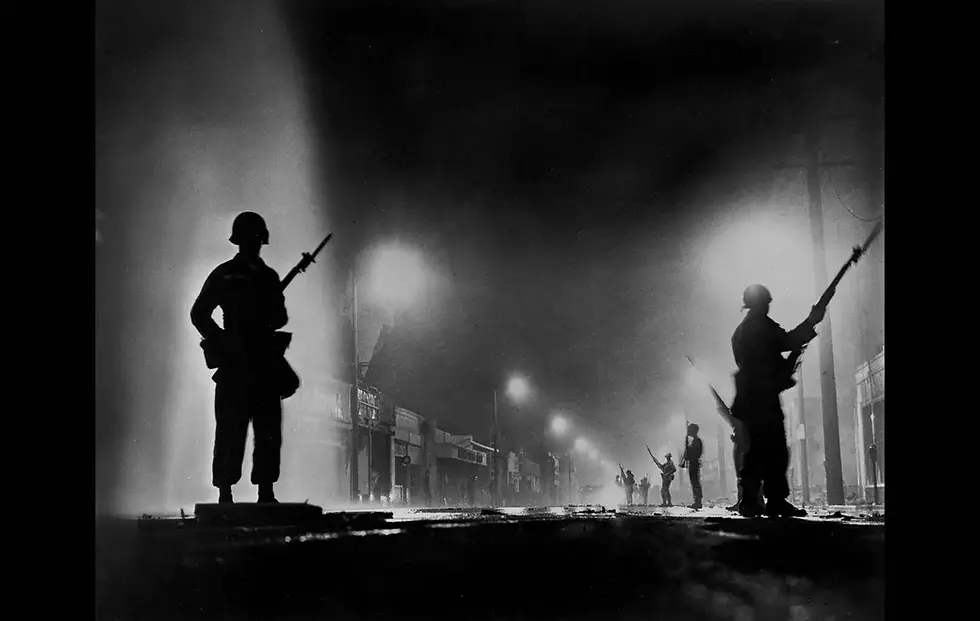The Watts Riots of 1965: Six Days That Shook Los Angeles
- Julian Beckett

- Aug 11
- 5 min read

On a hot August evening in 1965, a routine traffic stop in Los Angeles’ Watts neighbourhood spiralled into six days of chaos, destruction, and political reckoning. What began as an arrest for drunk driving ended with 34 people dead, more than 1,000 injured, and a city forced to confront decades of racial inequality, police brutality, and economic marginalisation.
The Watts Riots (also called the Watts Rebellion or Watts Uprising) were not just an eruption of anger over one incident. They were the product of years of tension, systemic discrimination, and mistrust between Los Angeles’ African American community and its police force.

The Long Road to Watts
To understand why Watts exploded in August 1965, we need to look decades earlier.
The First Great Migration (1915–1940) saw millions of African Americans leave the rural South for Northern and Midwestern cities in search of jobs and safety from the Jim Crow laws. Los Angeles was largely bypassed during this wave.
But during the Second Great Migration (1940s–1970s), the West Coast became a major destination. World War II created jobs in shipyards, aircraft factories, and other defence industries. President Franklin D. Roosevelt’s Executive Order 8802 banned racial discrimination by defence contractors, opening up work for Black Americans who moved west in unprecedented numbers.

In Los Angeles, the Black population swelled from around 63,700 in 1940 to roughly 350,000 by 1965. But jobs and opportunities did not come with equal rights. As one resident, Clara Johnson, later recalled:
“We came here thinking the West was different. But by the early 60s, you could see — same problems, just different street names.”

Housing Segregation and the “Invisible Walls”
Even after racially restrictive housing covenants were outlawed in 1948, discriminatory practices endured. By the 1940s, 95% of Los Angeles housing was effectively closed off to minorities.
Many African Americans were restricted to South Los Angeles, including Watts and Compton. Postwar suburban growth was rapid — but white flight, redlining, and blockbusting kept Black families from moving freely.

The 1963 Rumford Fair Housing Act attempted to open up the housing market, but California voters overturned it with Proposition 14 in 1964 — a move many historians and civil rights leaders saw as a direct provocation. Psychiatrist and activist Alvin Poussaint would later name Proposition 14 as a spark that helped light the fuse in Watts.

The LAPD and Chief Parker’s “Thin Blue Line”
By 1965, William H. Parker had been Chief of Police for 15 years. He was credited with professionalising the LAPD, but his approach — recruiting heavily from the South, fostering a military-style force, and resisting civilian oversight — deepened tensions with Black and Latino communities.
Reports of police brutality were frequent, and trust in law enforcement was virtually nonexistent in many neighbourhoods. Parker’s “thin blue line” metaphor, portraying police as civilisation’s last defence against chaos, did little to calm relations.

The Arrest That Sparked a Rebellion
On 11 August 1965, 21-year-old Marquette Frye was pulled over by California Highway Patrol officer Lee Minikus for suspected drunk driving. Frye failed a field sobriety test.
As Minikus prepared to impound Frye’s mother’s 1955 Buick, Frye’s brother ran to get their mother, Rena Price.

Accounts differ about what happened next, but we know voices were raised, tempers flared, and physical scuffles broke out. Frye was struck in the face with a baton, and police pulled a shotgun as the crowd watching grew to over 200 people.

Rumours spread quickly, most notably that police had kicked a pregnant woman. In an era before mobile phones, word-of-mouth and anger moved fast.
Years later, Frye reflected in an interview:
“It went from just me and the officer talking, to my whole world turning upside down. I saw my mother being grabbed, I heard people shouting… the air just changed.”

Six Days of Fire and Fury
The LAPD called in the California Army National Guard on 12 August. Chief Parker likened the unrest to guerrilla warfare against the Viet Cong, signalling a paramilitary approach.
What followed was a full-scale confrontation between residents and heavily armed police and soldiers. Arson, looting, and street battles left the streets looking, as one National Guardsman put it — “like a war zone in some far-off foreign country.”

Some businesses, especially white-owned stores accused of exploiting the community with high prices and low wages, were targeted. Firefighters were attacked or blocked from putting out fires.
One Watts resident, Eddie Mason, recalled:
“The night sky was orange. You could hear glass breaking for blocks. It wasn’t just anger — it was years of being ignored coming out all at once.”
By the time order was restored on 16 August:
34 people were dead — 23 of them shot by police or Guardsmen.
Over 1,000 people were injured.
3,438 arrests were made, most for curfew violations.
$40 million in property damage was recorded (over $380 million today).
977 buildings were damaged or destroyed.

Why Watts Burned
Civil rights leader Martin Luther King Jr. linked the uprising to California’s housing discrimination, particularly Proposition 14. Activist Bayard Rustin called it “the first major rebellion of Negroes against their own masochism,” a refusal to quietly accept slum life any longer.
Despite some officials blaming “outside agitators” or even communist influence, the McCone Commission, set up by Governor Pat Brown, concluded the deeper causes were unemployment, poor housing, inferior schools, and hostile police-community relations.
Its 101-page report recommended sweeping reforms — literacy and preschool programmes, better public transport, low-income housing, and improved healthcare. Most were never implemented.

Aftermath and Legacy
In the months and years after the riots, white flight accelerated in nearby suburbs. The LAPD reviewed its tactics, but Parker remained in charge until his death in 1966.
For many in the Black community, the Watts Riots were not just an explosion of rage — they were a turning point, a public declaration that the status quo was intolerable.
Journalist Robert Conot, who spent months interviewing residents, wrote:
“Watts was less a place than a pressure cooker. And in August 1965, the lid blew off.”
And while Los Angeles would not see unrest on this scale again until the Rodney King riots of 1992, the issues at the heart of Watts — inequality, police violence, housing discrimination — remain part of America’s ongoing conversation about race and justice.

Further reading / Sources
LIFE Magazine Photo Essay – Watts: Still Seething https://time.com/3640068/the-fire-last-time-life-in-watts-1966/
The Literature of Watts – Los Angeles Timeshttps://www.latimes.com/books/jacketcopy/la-et-jc-the-literature-of-watts-20150810-story.html
Martin Luther King Jr. on the Watts Riots – King Institute https://kinginstitute.stanford.edu/publications/autobiography-martin-luther-king-jr/chapter-27-watts
Oral Histories from the Watts Riots – The New Yorker https://www.newyorker.com/magazine/2020/06/22/the-history-of-the-riot-report
Set the Night on Fire: L.A. in the Sixties – Wikipedia Overview https://en.wikipedia.org/wiki/Set_the_Night_on_Fire:_L.A._in_the_Sixties
Watts Riots – Smithsonian National Museum of African American History & Culture https://nmaahc.si.edu/explore/stories/collection/watts-riots
The Watts Riots: 1965 – History Channel https://www.history.com/topics/1960s/watts-riots











































































































motocycle.